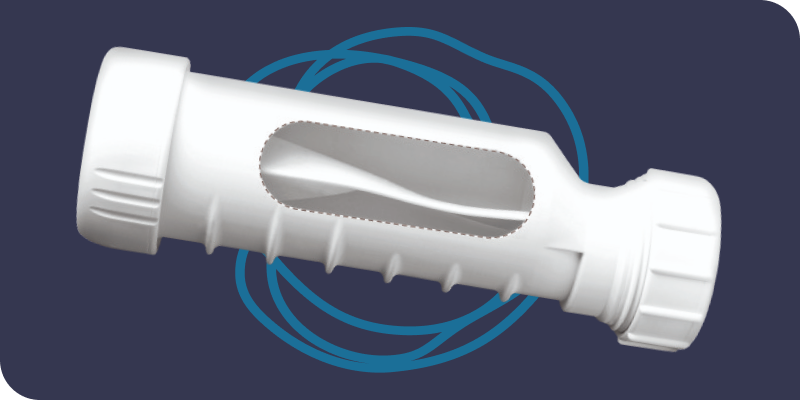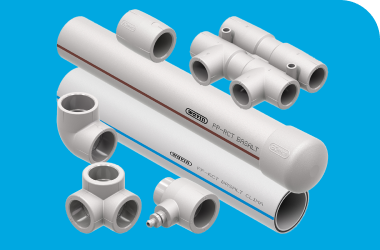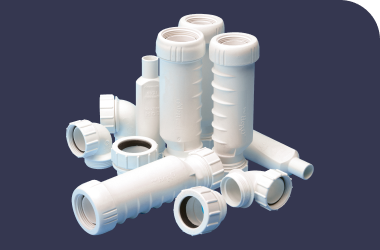
Have you ever walked into a home or building that has been closed or unused for several months and noticed a noxious smell? Most likely, a p-trap dried out, allowing sewer gases to permeate the living or working space.
Sewer gas contains compounds that can be toxic to humans in high concentrations: hydrogen sulfide, methane, ammonia, and carbon dioxide. Hydrogen sulfide can damage oxygen system organs. Methane and ammonia are highly flammable and present a dangerous fire hazard. It can also carry harmful viral pathogens and bacteria.
P-traps are the traditional vehicle to contain sewer gases under drains: sinks, showers and tubs, and washing machines. Water remaining in the bend of the trap seals off the pipe, blocking the gases from entering the room.
Sanitary waste valves (SWV) offer a compelling alternative to traditional p-traps for sporadically used locations such as vacation homes, guest bathrooms, dorms, stadiums, and seasonal facilities. Unlike p-traps, these devices provide permanent protection against sewer gas exposure, making them a valuable safety benefit in situations where water traps can evaporate.
With widespread success and application in Europe, Australia and Asia, we explore the potential of these SWVs and highlight their key benefits, addressing concerns and clarifying their current and future applicability.
1. Mitigating Sewer Gas Leaks and Stagnant Water
SWVs mitigate the problem of sewer gas odors escaping into buildings when the water seal on traditional p-traps dries out from evaporation. This is especially critical in hot climates where rapid water evaporation poses a greater risk and in installations with low or seasonal fixture use. With a fully depleted (or even partly depleted) water seal there is a clear pathway for harmful viral pathogens to enter into and spread through the living space.
The other major cause of p-trap seal depletion is siphonage, where negative pressure events in the drain-waste-vent system effectively suck water from the trap. Being waterless devices, waste valves are not vulnerable to this.
Sewer gas is not only unpleasant, it is potentially damaging to health. An open p-trap no longer provides the health protection it is intended to provide; retrospective replenishment with water is acting after the event and, at best, is a temporary fix.
The Wavin HepVOⓇ sanitary waste valve is not a water-filled device, so evaporation is not an issue. It uses a purpose-designed membrane to create an airtight seal between the living space and the drainage system — so no foul odors from the drain or sewer escape.
The self-sealing valve opens under the water pressure of a fixture emptying and closes to form a tight seal after the fixture has discharged under normal atmospheric conditions. The versatile device can be installed vertically or horizontally for many applications.
Furthermore, since there is no u-bend or "trap," SWVs promote more forceful drainline carry, an important consideration with many legacy piping systems oversized for today's low-water-use fixtures. They are more hygienic as vigorous drainline carry reduces stagnant water and retained waste debris in the piping, alleviating the growth of bacteria that can spread through dried-out traps.
P-traps, however, retain a reservoir of stagnant water — a smelly accumulation point for decaying waste and a breeding ground for bacteria.

2. Installation and Maintenance Simplicity
SWVs are easier to install, with fewer connections than traditional p-traps. The HepVO design allows for vertical, angled or horizontal installation. When installed horizontally, a minimum allowable slope of 1/8" per foot must be maintained to ensure good drainage.
Routine or seasonal maintenance system flushing is unnecessary, nor technically is it necessary to use branch air admittance valves to protect it from siphonage.
In cold climates, where frozen p-traps can crack, sanitary waste valves make sense as there is no need to winterize
Note that Wavin's HepVO is resistant to standard caustic-based drain cleaners. It is also resistant to acid-based cleaners with concentrations up to 10%. When flushing with higher concentrations of acid-based cleaner, the valve must be removed before the operation.
An occasional concern expressed by professionals is that SWVs must be removed before using a sharp-edged snake to clear clogs. While true of both p-traps and SWVs, it is important to note that SWVs reduce clogging potential by virtue of their straight design, which delivers faster linear drainage flow. This keeps the waste piping cleaner and reduces maintenance frequency.
In the event of a blockage downstream, the valve can be removed before cleaning the line. Normal drain-cleaning chemicals and plain-ended rods can be used with the valve in situ.

3. Vandalism Protection and Space Optimization
With their smaller size, SWVs offer valuable space-saving design possibilities, creating storage space and easing access for maintenance. They also can function more remotely from the fixture outlet, typically up to 6 feet away. Public restrooms can benefit from this capability, enabling installation behind removable partition walls to deter vandalism.
Some p-trap installations require cutting into the floor to accommodate its U-bend. HepVO's horizontal installation uses a 90-degree adapter to avoid damaging the floor. This is especially significant in luxury hotels or other buildings with beautiful and expensive flooring. Low-profile horizontal installations under vanity sinks can also take the unsightly plumbing out of view.
SWVs provide more design and installation flexibility by allowing horizontal or vertical configurations and optimizing space, providing much more flexibility than the traditional solution.

4. Compliance and Standards
Certified and Listed Waste Valves adhere to the stringent guidelines set by ASME/ANSI Standard A112.18.8 - 2020 - Sanitary Waste Valves for Plumbing Drainage Systems. Notably, there is no equivalent standard or testing requirement for traditional p-traps. By meeting rigorous established standards, these valves bring reliability and peace of mind to any plumbing system.
While these waste valves are well-recognized and proven in numerous regions globally, some limitations exist under North American building codes. Progress is underway, however.
These valves are approved for use in HVAC condensate drains under the 2024 Uniform Plumbing Code and 2024 Uniform Mechanical Code. For other specifications, system designers can use the "alternative materials provision" of the codes.
They have been accepted under the NFPA 1192 RV Plumbing Code for many years, with widespread use on new-build recreational vehicles. This is arguably a more demanding application for a trap and a testament to the effectiveness and robustness of these devices. In addition, they are widely used in the United States as a problem-solver on existing installations that are failing due to evaporation or siphonage.
SWVs such as HepVO offer an effective and efficient alternative to traditional p-traps: versatile installation, no foul odors, no gurgling noises, no limescale, hygienic, space-saving, easy flow, improves venting to negative pressure, performs under back pressures, effective in hot and cold conditions, and copes with food waste.
The undeniable benefits make HepVO worthy of consideration, especially in sporadic-use installations.





.png?width=380&height=250&name=wavin-us-pprct%201%20(1).png)
